

The Ultimate Guide to Scaled Agile Frameworks: SAFe, LeSS, DA, Scrum@Scale






Scaling Agile is the buzzword taking the software industry by storm and gaining popularity in other sectors like manufacturing, eCommerce, and retail. Agile software development has been around for the past 20 years. The approach to software development has evolved since its inception to help businesses keep up with the market pace. Agile basically comes down to the notion that software should be delivered at regular intervals, giving the customer the option to accept the software rather than wait for them to accept it.
Hey there! This blog is almost about 3900+ words long & not everyone likes to read that much. We understand that.
This is precisely why we made a podcast on the topic. Mitul Makadia, CEO & Founder of Maruti Techlabs, talks to Bikshita Bhattacharyya about his Agile implementation, strategy, and process during the nascent stages of the company.
He walks us through the challenges he faced, how the business benefited from scaling Agile, and how important is the scrum master in making Agile a success at the organizational level. Here is a small snippet from that episode. Check it out!
According to a research study conducted by Project Management Institute, 75% of the organizations with higher agility report a minimum of 5% year-over-year revenue growth. It is compared to only 29% of organizations with lower agility reports. Moreover, SAFe can reduce the time to market by at least 40%. Scaling Agile is not about creating more efficient teams; it’s managing the challenges larger organizations face while working with Agile techniques.
The Scaled Agile Framework or SAFe is the most popular agile framework. It was first recognized in the year 2011. The Software-Industry veteran and the author of Agile Software Requirements, Dean Leffingwell, called the SAFe framework “Agile Enterprise Big Picture.” The “Big Picture” creates leverage for the foundation pillar of the SAFe framework.
SAFe comprises broad knowledge base practices to deliver successful software products. Today, SAFe is the most popular agile scaling framework with a long list of knowledgeable and successful patterns available for free.
In this blog, we will cover the challenges and benefits of scaling agile, 4 Agile Frameworks, and their characteristics and detailed comparisons of some of the frameworks to help you decide which framework is proper for you ultimately.
Scaling agile is the process of taking proven agile methods, like scrum and kanban, and using them with a more extensive diverse set of people in larger groups. Traditionally, agile works best in groups that are no bigger than 11 people.
Companies succeed by allowing small groups of employees to define their own goals and design products. They eventually want to apply the same freedoms and successes to a more extensive department. Unfortunately, this is where most companies run into trouble: their people lack consistent motivation and rely too heavily on their managers for instruction. This is where scaling Agile comes in.
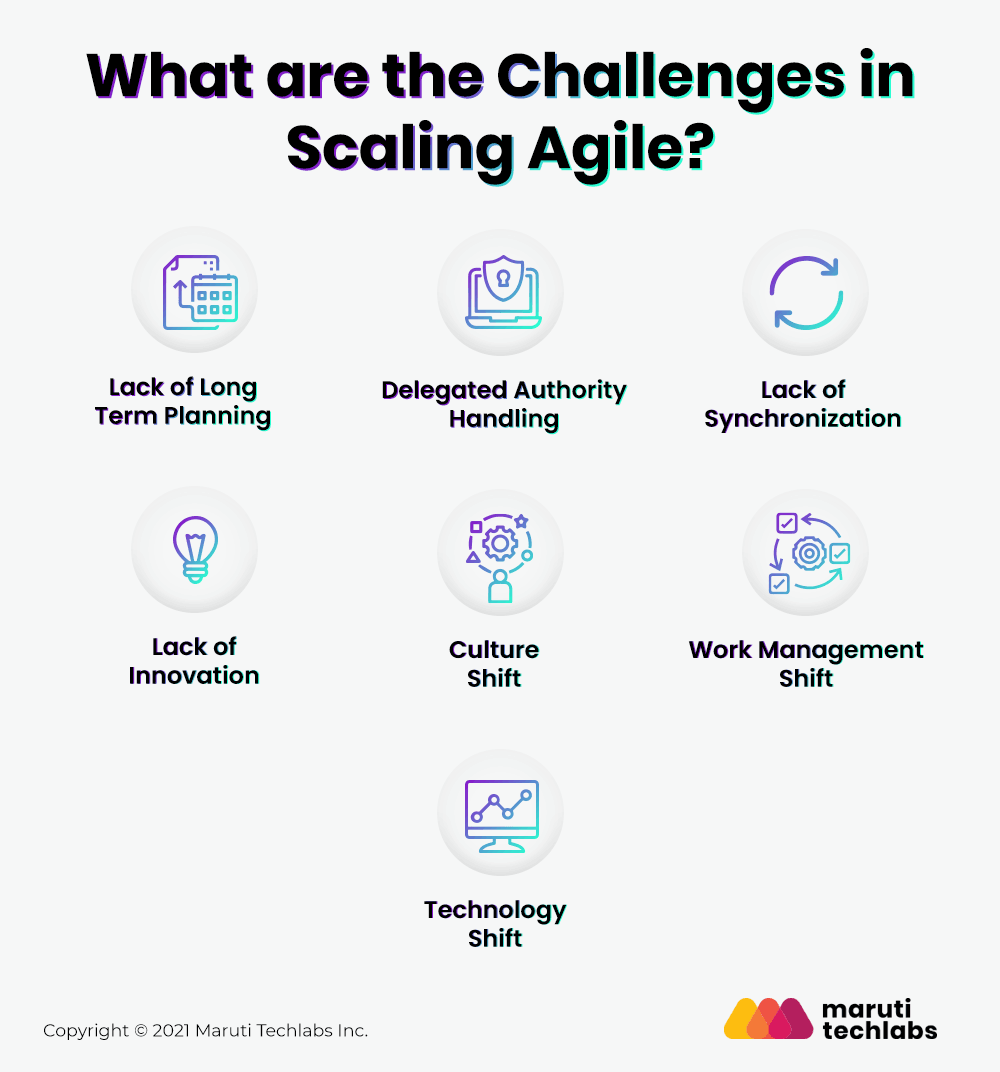
Transforming the thoughts and execution of work on an organizational level is quite a difficult task. Even most experienced Agile software developers and forward-thinking enterprises face trouble while scaling Agile.
Below are some of the hurdles that an organization faces when it comes to scaling agile principles and practices:
Generally, the agile development team implements the SAFe agile methodology to improve their product backlog to two to three iterations.
The product marketing team usually releases the product and performs a high-level roadmap of 12-18 months. Later they co-operate on these plans for three months of work.
The agile development team would clear the backlog for two to three iterations and have detailed task plans ready. New changes are often limited to the subsequent iterations.
In the Scrum framework, the product owner accepts the charge of the product life cycle accompanied by investment return. There is a requirement to view multiple team backlogs on a larger scale. A product manager is fully accountable for controlling multiple team backlogs. The Product Owner is quite separated from the development of the organization, which leads to a barrier.
The scaled agile framework enables the development team to create their ways of work. There are many development teams at large-scale organizations, and it proves difficult for the team to be entirely self-organized.
The self-organized teams working on similar products will challenge synchronizing their deliverables and delivering them together.
Additional Read: Guide to Scrum of Scrums – An Answer to Large-Scale Agile
In large organizations, additional iteration is required after a release of the product to improve its performance. A large-scale agile model requires testing everything which is operating simultaneously till the end.
Agile is often expressed as a culture instead of a set of principles. The scaled agile framework is often less critical than its culture, but it can be challenging to create.
The Agile expert author, Steve Denning, explains: “The elements of a culture fit together as a mutually reinforcing system and combine to prevent any attempt to change it. Single-fix changes at the team level may appear to make progress for a while. Still, eventually, the interlocking elements of the organizational culture take over, and the change is inexorably drawn back into the existing corporate culture.”
Denning’s prediction is entirely accurate. Agile scaling methods require the entire organization to process, act and react differently in every dimension. Unsuccessful shift to company culture is one of the primary challenges faced by agile transformation failure.
When transforming an organization to be agile, the culture needs to shift to become more agile. Value-driven organizations are guided by principles that empower people. To be agile, trust must be built throughout the organization for anything that gives value to customers and facilitates agility throughout the company.
The traditional project management approach begins with a fixed goal and estimates the resources and time necessary to achieve that goal. This process defines the requirements of the organization and eventually reduces the risk by increasing success.
On the other hand, the lean-agile model flips the above paradigm. Resources and time become more fixed by establishing iteration windows and teams. Teams experiment and receive feedback quickly so that organizations can adapt nimbly.
Organizations can shift their flow of work in the scaled agile framework by doing the following things:
Organizations working towards scaling agile must be familiar with their technology stack. Scaling agile creates increased visibility, transparency, and information flow across the organization. It means evaluating and augmenting technology solutions.
Technology tools need to support alignment at a tactical level. Development teams cannot scale agile successfully without the right solutions even if the culture and workflow are properly aligned. Which technological tools can smooth scaling agile? The answer depends on the agile maturity of the organization.
If businesses already intake multiple agile teams, scaling agile means implementing a practice connecting them for better transparency and workflow. Going beyond the basics of scaling agile at the team level requires mapping how multiple agile teams are connected in the greater scheme of things. This may mean using a strategic map to view agility capacity at product life cycle phases and across multiple deliverables. The workload can be mapped into actual tasks, financial contributions by team, impact on strategic goals, and ultimately efficiency.
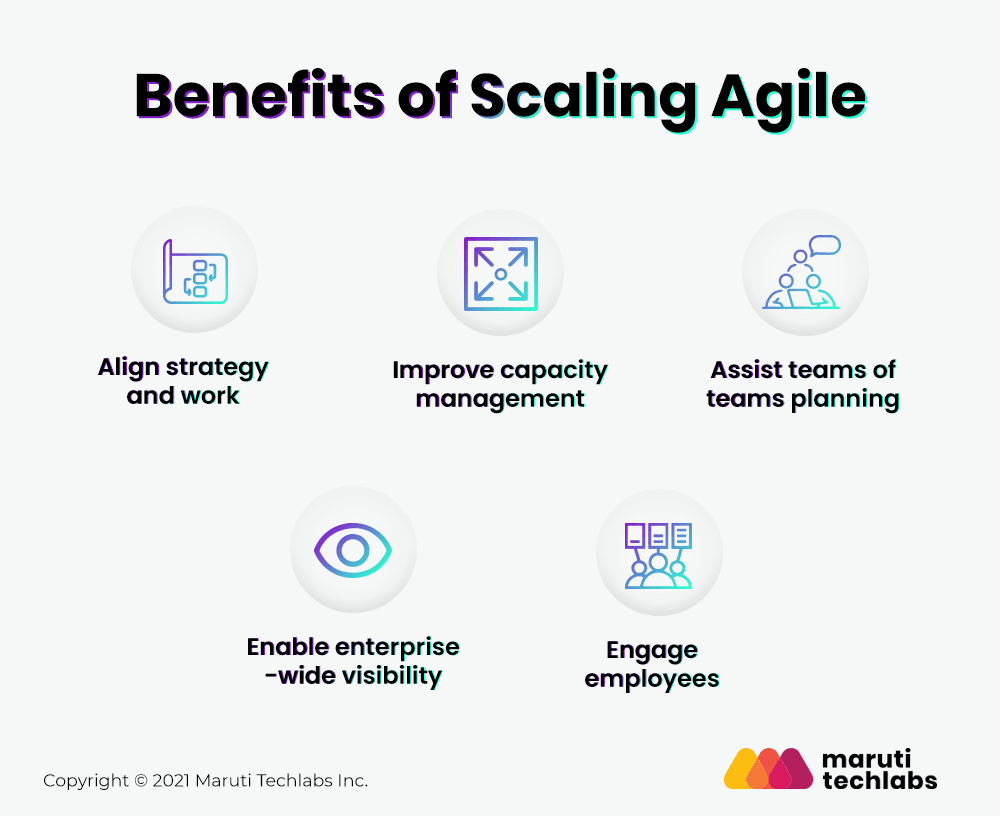
As scaling agile involves management, culture, and technology shifts, the benefits are far superior to the challenges. Alignment, built-in quality, transparency, and program execution represent the core values of the scaled agile framework.
In an organization, transforming workflow to a scaled agile framework brings countless tangible and intangible benefits. Businesses that scale Agile tend to go to market quicker while increasing customer satisfaction and ROI. Moreover, successful Agile companies report that they’re better able to attract top talent than their less agile valued agile counterparts. Let us discuss some of these benefits in detail below:
Scaling Agile enables connecting the organization’s top-level objectives with the people responsible for achieving them. This alignment helps to create numerous effects like boosting cross-team coordination, fostering transparency, enabling faster response times, and many more.
Scaling agile also emphasizes creating ARTs(Agile Release Trains) to ensure that the team objectives are aligned, and everyone in the organization is centered on producing value for customers.
The capacity management is aligned to the ARTs and regularly evaluated with a scaled agile approach. These methods focus on flexibility and change, empowering leadership to reflect and rebalance regularly and minimizing the disturbance to organizational flow. Management helps from stabling the teams with specific metrics to persistent making informed decisions about who can take on how much work.
Scaling agile across the organization requires different people from multiple teams and departments together under the same umbrella. It may occur throughout the organization within every department like Dev and Ops, but it always requires greater coordination.
Scaled agile frameworks solve this matter by quarterly planning events which bring cross-functional teams together and build plans that highlight potential dependencies, deliver against corporate goals, and identify the risks. These “teams of teams” play prominent roles in scaling agile by giving everyone in the organization clear visibility into quarterly deliverables.
Visibility doesn’t only come from planning. Scaling agile enables transparency across the organization by connecting and visualizing the work by every team member.
Leaders and managers gain a big picture of potential barriers and make clear choices to allocate the work appropriately. Scaling agile allows them to visualize how ARTs or teams of teams measure their progress and performance, deliver their products, and gauge the financial impact of their work.
Scaling agile is deeply rooted in trust at the team and individual levels. People are empowered to make choices about how their work is delivered, impacting the high-level business goals. This trust translates to happier and more engaged employees who can eventually benefit the business with a lower turnover rate, high productivity, and great user experience.
Scaled Agile Framework principles are designed to identify the challenges while scaling agile methods in software engineering. It provides the organization with a roadmap to scaling agile in effective and efficient ways.
Many agile scaling frameworks exist to help your organization but let us discuss the top 4 of them in detail below:
The SAFe agile methodology combines Agile, DevOps, and Lean practices for organizational agility. It guides product delivery on three levels and adds guidance on extending agile across your organization with its fourth portfolio level.
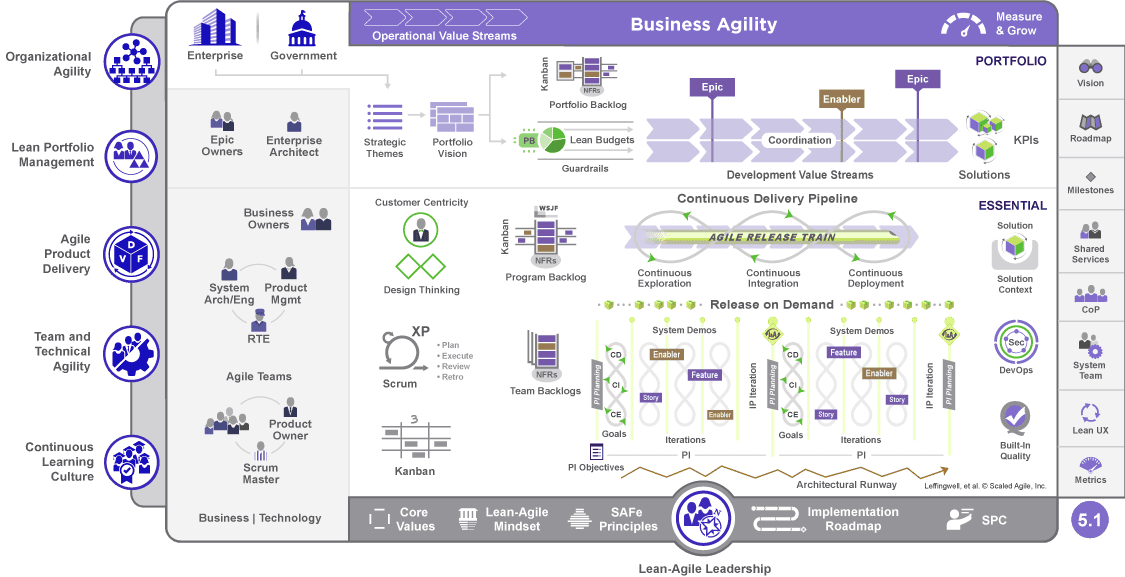
The Scaled Agile Framework defines itself as an “integrated practices, principles and ability for achieving business agility using Lean, Agile and DevOps.” It involves planning at the team, program, and portfolio levels.
Many agile practitioners express SAFe as complex and over-prescriptive. However, for very large organizations, this can be a blessing in disguise. It performs many roles, practices, and events that add some complexity and require significant commitment to adopt.
The SAFe framework gives concrete guidance without forcing you to immediately rebuild your organizational structure or product architecture to help reduce your team dependencies.
One scaled agile framework tool for quarterly planning events is Program Increment Planning (PI planning). It is a top-down collaborative planning cycle to overarch the standard Scrum Sprint cycle.
PI planning enables you to align with everyone on the strategic goals for the next three months. It helps surface the dependencies between departments and prioritization to move efficiently towards the PI goal.
SAFe is an important Scrum plus several XP practices at the team level. Teams can choose to work with some Kanban practices to manage their workflow. The program level coordinates team efforts with PI planning and teams of teams known as Agile Release Train(ART), Release Train Engineer, as a coach who facilitates the ART events.
If you have a large product on which more than 150 people are working, the SAFe framework computes a solution train to coordinate the various ARTs whose role is similar to the RTEs but at a more integrated level.
Scrum@Scale was published in 2017 as a new block in the agile scaling framework, which enables you to scale agile for product delivery.
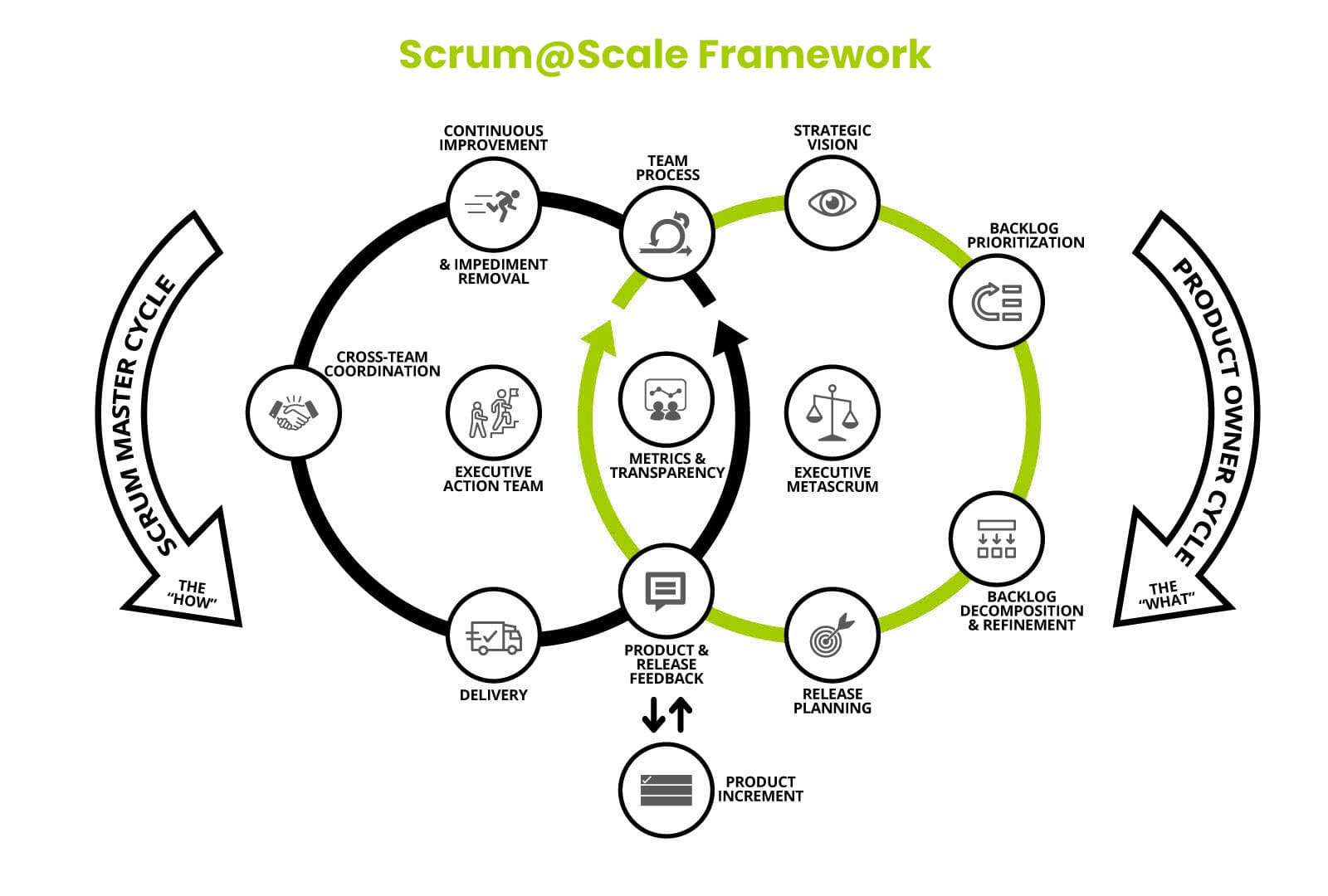
‘Scrum at Scale’ follows the concept of including five people as a team, concentrating on linear scalability, and emphasizing reducing the time it takes to make decisions in an organization.
It helps to keep the product and the process separate from what scrum does for a single team. It defines two overlapping cycles, i.e., Scrum Master Cycle for delivering product and Product Owner Cycle for discovering product. SaS defines the components with a purpose in both of these models. They enable you to customize your transformation with tactics beyond the core design and ideas of each. It also establishes alignment with your organization’s strategies, vision, and goals.
Each cycle has a group to support effective operation, i.e., an Executive MetaScrum (EMS) to fulfill the product owner role at the higher level. An Executive Action Team focuses throughout the organization to process the improvements in the scrum master cycle.
LeSS is a framework used for product delivery in scaled agile development. The idea behind this framework is to allow you to do more with less availability. It helps you to avoid overhead and local optimizations.
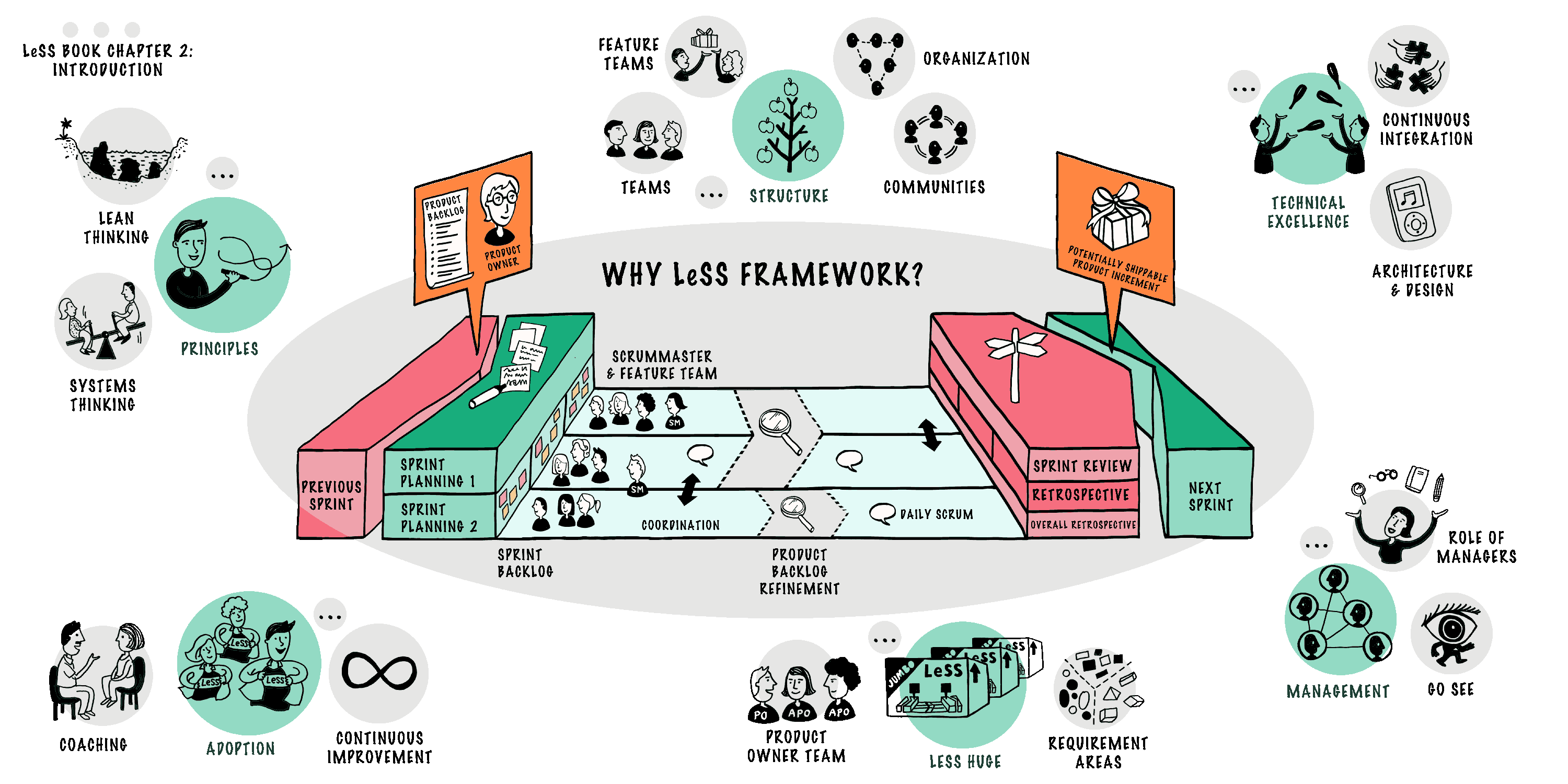
LeSS allows you to adopt a complete product concentration by your team around the diverse ways your product brings value to your customer. For example, a team focuses on the texting features, while another team focuses on voice features.
LeSS is a single-team Scrum with few modifications, just like the Scrum-based framework. It helps you add an overall retrospective and initial part to sprint planning and replaces the per-team sprint feedback with all-team.
Therefore, the LeSS framework manages the challenges of scaling agile principles through a specific lens of Scrum and helps your organization find out “how to implement the principles, purpose, elements as simple as possible.”
LeSS uses teams as its base building block by reducing management’s role and prioritizing simplicity versus strictly defined processes. It is one of the impactful approaches for any organization that already uses Scrum principles and wishes to scale agile in a streamlined and robust way.
Disciplined Agile was started as Disciplined Agile Delivery with the goal of product delivery. Eventually, it was renamed as Disciplined Agile to reflect its scope. By 2017, DA showed how organization functions work together and when they should address the scaled agility for the enterprise.
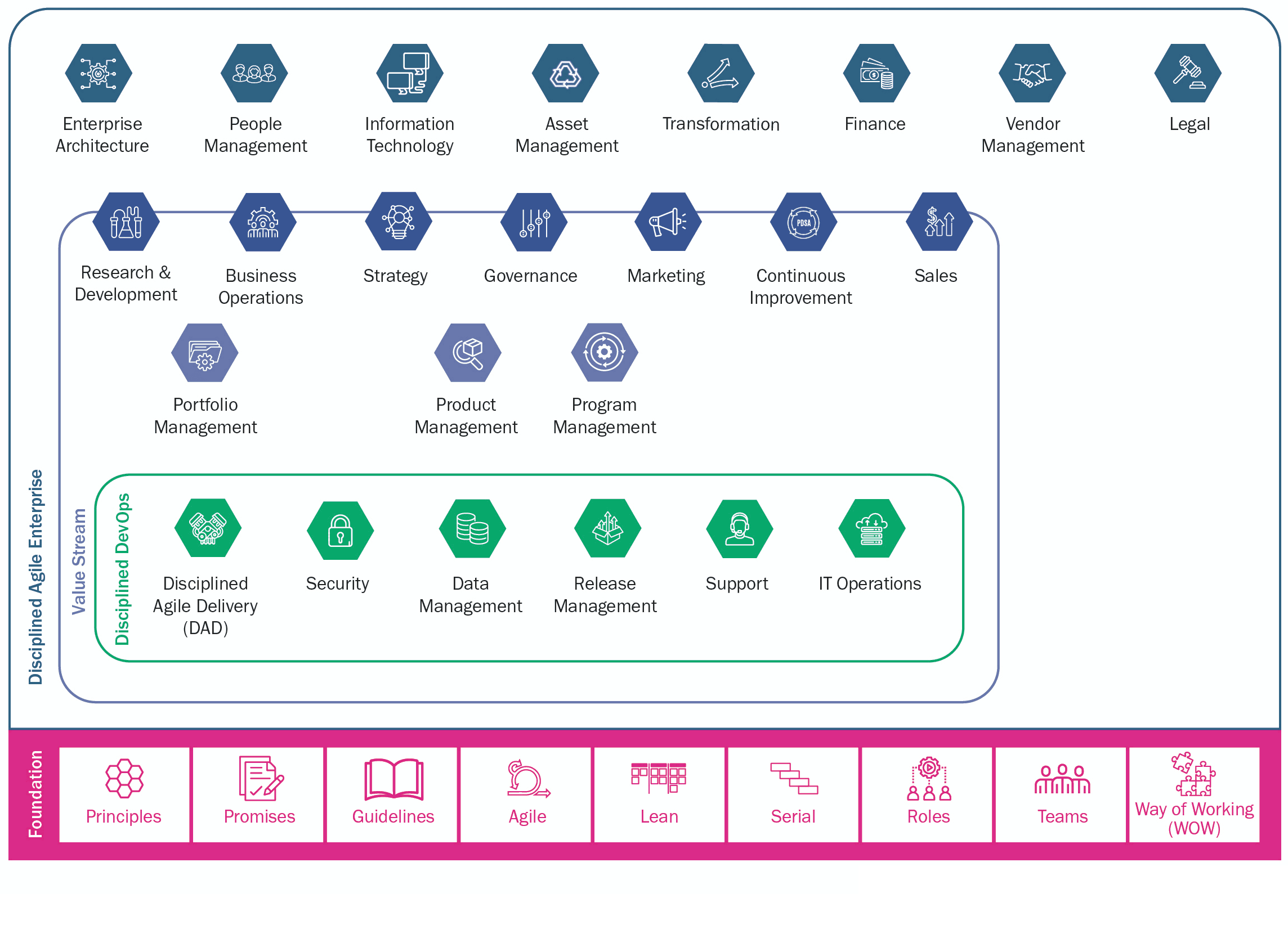
Disciplined Agile is a toolkit that combines hundreds of scaled agile practices to guide you in the best possible way of working for your team and organization. It highlights the team roles and goal-driven methods that make it more flexible in comparison to other frameworks. DA is less prescriptive in comparison to SAFe and mostly oriented towards the foundation of the approach to Agile rather than a strict “recipe” of scaling Agile.
DA is lightweight and helps throw light on “what” and the required tools to make it happen. However, it leaves the answer of “how” up to you. Disciplined Agile gives instructions on four different levels:
The DA toolkit is a superset of all tools used in other approaches, even though it is lightweight because it does not force you to work in any particular direction to mix and match and create your framework without starting from scratch.
While scaling agile, all of the above approaches or their alternatives are right and wrong at the same time. The choice of the best framework depends on the background, needs, team, and organization. Each of the above scaled agile frameworks approaches to scale agile differently, but it also accepts the challenges with the speed bumps that every business should get rid of.
The Scaled Agile Framework is one of the most successful frameworks for scaling Scrum in large organizations. It is important to note that the SAFe (scaled agile framework) is planned to accommodate DevOps, a process likely to be considered as the future-proof Agile organization.
SAFe or scaled agile describes a highly structured approach to engage with the Agile value stream in an enterprise setting. Large organizations should process the structure as possible while gaining the advantages of the decentralized Agile methods.
Scrum at Scale is rather untested and undocumented than SAFe, making it less suitable for extensive enterprise adoption. Scrum at Scale supports scaling the framework as the structure of SaS is easy to manage but hard to master.
If you compare SAFe versus Scrum at Scale, SAFe is too rigid. Hence, it is based on the top-down approach and eventually introduces various levels, events, and roles to retain enterprises’ organizational structure. It adds complexity, so SAFe is not easily adapted to specific environments compared to another framework.
On the other hand, Scrum@Scale is based on a scrum-of-scrum approach to ensure the scalability of the fundamentals of Scrum. It is flexible, making an appealing choice for the teams working on a critical product where ample documentation is required for ensuring audibility.
The SAFe (scaled agile framework ) provides the organization with highly reliable methods for outlining the performance and delivery of the product. It performs flawlessly in organizations with hundreds of teams simultaneously.
Below are some of the advantages provided by SAFe for scaling agility in an organization:
Below are some of the challenges faced by SAFe scale agile:
The scaled agile framework is an overall solution for portfolio and business agility. It is an excellent choice for organizations to achieve total enterprise agility and a highly disciplined approach to deliverables.
On the other hand, Large Scale Scrum(LeSS) is a large-scale implementation of the principles and practices of Scrum among cross-cultural teams. It helps to redirect team awareness over the entire organization. LeSS includes a couple of frameworks, including the eight teams, and estimates more than eight teams simultaneously.
Some of the common advantages of the LeSS framework are:
Some significant challenges faced by LeSS for scaling Agile are:
As mentioned earlier, there are numerous scaled agile frameworks for any organization that consists of diverse teams working on a similar product. To get the best results, you can merge the best practices of different frameworks. Hopefully, the SAFe vs. LeSS comparison will make your decision-making process more efficient.
Did you find the video snippet on How to balance team efficiency with individual learnings in an agile environment? to be insightful? We have a ~22 min video where Mitul Makadia gets into the weeds, and we discuss about Implementing & Scaling Agile to streamline Software Development. Take a look –
To conclude, SAFe, a regularly evaluated agile methodology is the most popular framework for scaling agile among the organization because many of its features focus on eliminating the challenges faced by the team members.
In other words, if your business is beginning to transition to agility, SAFe is the best choice to bridge the gap of transformation. A SAFe framework is a prescriptive approach compared to Disciplined Agile, which provides more flexibility but at the same time requires an organization to understand the agile philosophy fully.
If your question is which scaled agile framework to pick, below are some general points to consider for making the right choice.
Scaling agile is challenging, but with the right technology, approach, and framework, you can enact a meaningful change at every level of your organization.
If you are still thinking about which Agile framework would best suit your business and how to implement an Agile methodology without shaking your existing practices, then you can trust dedicated Agile development teams to execute it for you.
At Maruti Techlabs, we have a passion for innovation and strive to deliver exceptional products to our clients. We truly believe in creating value for our clients and partners by focusing on creating value for their customers. Our competitive advantage in comparison to others is our extensive experience in the field of scaling agile development and water-tight processes that govern a strong rate of technical delivery.
Having built and shipped hundreds of products over the last decade (2 of them being our own – WotNot and Alertly) – we know a thing or two about scaling product development with the right mix of processes and frameworks for optimal results. Whether you are a startup, SMB, or an Enterprise – we can help in going from idea to MVP, tech stack modernization to standardizing your software engineering process with the right development framework that suits your business needs. Connect with our team for a free consultation and see how we can help you scale agile with our product development services.


